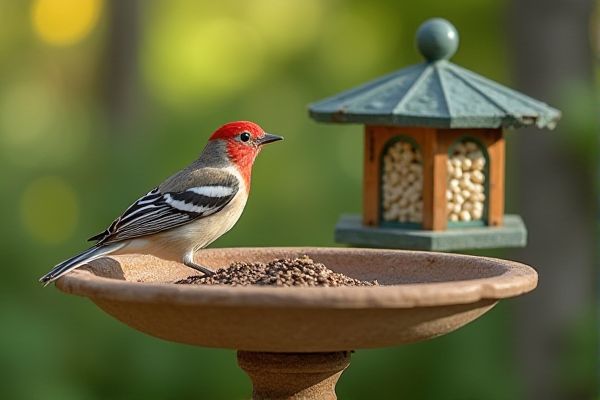
A bird bath attracts birds by providing a source of fresh water for drinking and bathing, while a bird feeder offers a consistent supply of food, encouraging frequent visits from a variety of bird species. Understanding the differences between these two bird-watching essentials can enhance your backyard experience, so explore the rest of the article to learn which one best suits your needs.
Table of Comparison
| Feature | Bird Bath | Bird Feeder |
|---|---|---|
| Purpose | Provides water for drinking and bathing | Offers food for birds |
| Attracts | All bird species seeking water | Primarily seed-eating birds |
| Maintenance | Regular water change to prevent algae | Frequent refilling and cleaning to avoid mold |
| Placement | Visible, sunny, safe from predators | Near trees or shrubs, sheltered location |
| Seasonal Use | Used year-round, water freezes in winter | Used year-round, varying food types by season |
| Types | Pedestal, hanging, ground-level baths | Tube, hopper, platform, suet feeders |
| Benefits | Supports hydration and bird health | Supports bird nutrition and diversity |
Introduction to Bird Baths and Bird Feeders
Bird baths provide essential water sources for birds, promoting hydration and bathing to maintain feather health. Bird feeders supply a variety of seeds, nuts, and suet, attracting diverse bird species by meeting their nutritional needs. Combining both encourages frequent visits, supporting local bird populations and enhancing backyard wildlife observation.
Purpose: Attracting Birds to Your Garden
A bird bath provides a vital water source, attracting birds for drinking and bathing, which helps keep your garden lively and healthy. Bird feeders offer a reliable supply of food, drawing a diverse range of bird species throughout the year. Choosing between a bird bath and a bird feeder depends on whether your goal is to encourage natural bird behaviors like bathing or to provide nourishment that supports bird populations during scarce seasons.
Key Differences Between Bird Baths and Bird Feeders
Bird baths provide water for drinking and bathing, supporting bird hygiene and hydration, while bird feeders supply food that attracts specific bird species. Baths typically feature shallow basins with clean water, promoting bird health and activity near your yard, whereas feeders come in various designs offering seeds, suet, or nectar to meet diverse dietary needs. Understanding these differences helps bird enthusiasts create a more effective and inviting environment for local wildlife.
Benefits of Installing a Bird Bath
Installing a bird bath attracts a diverse range of bird species by providing a reliable water source for drinking and bathing, which supports their health and feather maintenance. Bird baths also enhance your garden's ecosystem by encouraging natural pest control and pollination through bird activity. Your outdoor space becomes a lively, engaging habitat that promotes birdwatching and relaxation.
Advantages of Using Bird Feeders
Bird feeders provide a consistent and targeted food source, attracting a wide variety of bird species and supporting their nutrition year-round. They offer opportunities for birdwatching and photography by encouraging birds to visit specific locations. Feeding stations also help in monitoring bird populations and contribute to local ecosystem health by supplementing natural food supplies during scarce periods.
Maintenance Requirements: Bath vs. Feeder
Bird baths require frequent water changes, ideally every day or two, to prevent algae growth and mosquito breeding, demanding consistent cleaning and refilling. Bird feeders need regular inspection to remove spilled seeds, moldy food, and to prevent clogging, ensuring bird health and reducing pest attraction. Both bird baths and feeders benefit from routine maintenance, but baths typically require more daily attention due to water quality concerns.
Ideal Placement for Bird Baths and Feeders
Ideal placement for bird baths requires a sunny spot with partial shade to keep water cool and fresh, situated near shrubs or trees for birds to perch and take cover. Bird feeders perform best when placed 5 to 10 feet from dense vegetation, minimizing predator threats while allowing birds quick access to food. Both should be positioned away from areas with heavy foot traffic to ensure a safe and inviting environment for diverse bird species.
Best Types of Bird Baths and Feeders
The best types of bird baths are made from durable materials like ceramic, stone, or metal, featuring shallow basins with textured surfaces to provide birds a safe, non-slip grip. Optimal bird feeders include tube feeders for small songbirds, hopper feeders for mixed species, and platform feeders that accommodate larger birds, all designed with weather-resistant materials and easy cleaning features. Both bird baths and feeders that incorporate biodegradable components and offer natural water filtration or squirrel-resistant mechanisms promote sustainable birdwatching experiences.
Bird Species Attracted by Baths vs. Feeders
Bird baths attract diverse bird species such as robins, bluebirds, and cardinals that seek water for drinking and bathing, especially during hot weather or dry seasons. Bird feeders typically draw seed-eating birds like finches, chickadees, and nuthatches, providing essential nutrition throughout the year. Your choice between a bird bath and feeder directly influences the variety of birds visiting your garden and supports their unique needs.
Choosing the Right Option for Your Backyard
Selecting between a bird bath and a bird feeder depends on your backyard's ecosystem and the bird species you want to attract. Bird baths provide essential water sources for drinking and bathing, promoting bird hygiene and cooling, while bird feeders offer nutrition that supports feeding habits year-round. Enhancing Your backyard habitat with the right combination of water and food encourages diverse bird visits and helps maintain local wildlife health.
 homyna.com
homyna.com